Abstract
Accurately identifying and delineating urban functional areas has seen increasing demand in smart urban planning, landscape design, and resource allocation. Recently, POI (point of interest) data have been increasingly applied to identify urban functional areas. However, heterogeneity in urban spaces or the corresponding POI data has not been fully considered in previous studies. In this study, we proposed a new scheme for urban-functional-area identification by combining POI data, OpenStreetMap (OSM) datasets, and high-resolution remote-sensing imagery. A function-intensity index that integrates the quantitative-density index and average-nearest-neighbor index (ANNI) of POIs was built for representing the urban function. The results show that the proposed function-intensity index can balance the impact of the spatial heterogeneity of each type of POI on determining the functional characteristics of the urban units. In Futian District, Shenzhen, China, the method was effective in distinguishing functional areas with fewer POI amounts but high ANNIs from those functional areas with dense POIs. The overall accuracy of the proposed method is about 11% higher than that of the method using the POI density only. This paper argues for considering both the quantitative density and spatial heterogeneity of POIs to improve urban-functional-area identification.
1. Introduction
Urbanization accelerates the concentration of the population into urban areas, resulting in rapid urban expansion. In the process of urbanization, various elements evolve and are assembled in certain urban regions, forming heterogeneous urban spaces [1]. Spatial heterogeneity is one of the fundamental aspects of urban systems [1,2,3], and it can take many forms. First, a city as a geographical presence has spatial differences in biological and physical characteristics [4], such as the topography, vegetation cover, surface permeability, and type and density of buildings. Then, according to the adaptability of different urban spaces, differentiated human exploitation activities result in the spatial heterogeneity of land use [5]. Moreover, in the process of urban land use, the migration and mobility of socioeconomic elements among different social groups form the heterogeneity of social functions [6]. The scale and pattern of these different heterogeneities affect the aggregation and dispersion of human and social capital in urban areas, resulting in complex urban functional zoning. Urban functional areas are widely used as basic units for commercial site selection, urban transportation planning, and economic- and population-related studies [7,8]. Accurately identifying and delineating urban functional areas has been in increasing demand in smart urban planning, landscape design, and resource allocation in recent decades [7,9].
Traditionally, information on urban functional areas is mainly collected by experienced personnel using a variety of maps (e.g., thematic, topographic, land-use, and administrative-boundary maps), aided by relevant data, such as field surveys, questionnaires, and building-permit data [10], which is not only time consuming and laborious, but also potentially inaccurate due to subjective factors. Over the last few decades, remote-sensing data have been extensively used in urban domains. Many studies have focused on multisource remote-sensing images to extract urban land information, monitor land-use change, and study urban spatial structures and functions [11,12]. However, the use of remote-sensing images for urban-land-use classification, whether pixel-based or object-oriented, mainly deals with the spectral and textural features of urban areas, and cannot effectively reflect the socioeconomic attributes of the spatial units [13]. In addition, remote-sensing classification models often overlook the spatial arrangement and semantic features of ground components because they were only designed to mine the low-level semantic land-cover information of ground components [12,14]. In simple terms, remote-sensing techniques perform well in extracting physical characteristics, which include land-surface buildings and urban spatial structures, but they are incapable of reflecting information on human activity or of understanding dynamic environments. Therefore, it is difficult to accurately identify urban functional areas using remote-sensing images alone, and especially in urban areas with complex functional compositions.
Recently, using crowdsourced data, such as social-media, mobile, bus, location-based-service (LBS), and point-of-interest (POI) data, to recognize urban functional areas, has gradually become a research hotspot [15]. As one of the most common types of crowdsourced data, POI data are free and relatively easy to obtain [16,17]. In addition, POI datasets have the advantages of detailed information coverage, large data volumes, high precision, frequent updates, and convenient spatial analysis, making them one of the most frequent data types used for urban research, and urban-functional-area identification as well [18]. When POI data are employed to identify the urban functional area, two main steps are included. The first is to delineate the spatial units. Some studies directly used OSM blocks as the functional-area units [19,20,21,22]. In addition, classifying remote-sensing images or clustering other social-media big data, such as cell-phone-location data and cab-track data [13,23,24], is often used to implement the spatial division. The second step is to assign POI semantic information to the spatial features extracted in the first step. Current studies mainly use statistics towards POI amounts, such as the density index, as the criterion [25,26]. However, heterogeneity in urban spaces or the corresponding POI data has not been fully considered in previous studies, which has often resulted in a strong bias identification. As POI data are usually produced irregularly with spatial heterogeneity [18], effectively quantifying indicators by incorporating the spatial heterogeneity of POIs is required to accurately relate the abundant semantic information to the functional types.
This paper proposes a method to quickly identify urban functional areas based on POI data and high-spatial-resolution remote-sensing imagery. Specifically, the distribution characteristics of POIs were fully incorporated based on the average-nearest-neighbor index to sufficiently improve the accuracy of the functional-zone identification. The method was then applied to the Futian District of Shenzhen, China, and the advantages and limitations are discussed.
2. Materials and Method
2.1. Methods
The methodology of functional-area identification based on POIs and remote-sensing imagery is shown in Figure 1. The first step is spatial-unit partitioning based on remote-sensing imagery and OSM. Then, the average-nearest-neighbor index (ANNI) and the densities of all types of POIs in each spatial unit were calculated separately, and the function-intensity index () was constructed based on the weighted summation of the normalized density and normalized average-nearest-neighbor index of each type of POI in the spatial unit. Finally, the main functional attributes of each spatial unit were determined using the Grubbs criterion, based on the ratio of the function-intensity index of each type of POI.
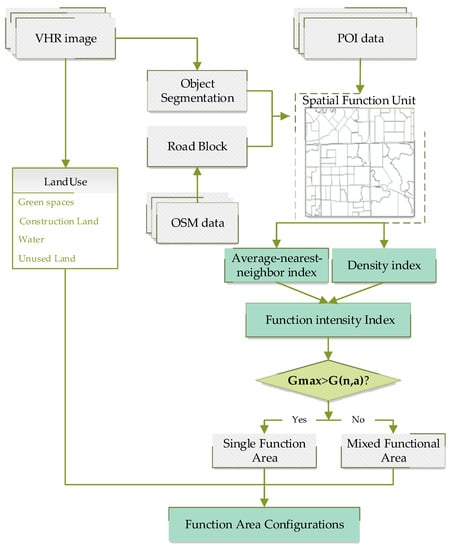
Figure 1.
Flowchart of functional-area identification based on POIs and VHR satellite images.
2.1.1. Spatial Unit Partitioning
Traffic-analysis zones based on road networks are commonly used as an urban functional unit. However, their coarse scale often brings about a large number of mixed-function units, resulting in low recognition accuracy. In this study, we fused road-network and feature boundaries formed by segmentation with remote-sensing images to obtain spatial units for the functional-area identification (Figure 2). We first used the object-oriented method to obtain the feature boundary and land-use type based on the Gaofen-1 remote-sensing image in eCognition software. The image was broadly classified into four categories, including water bodies, green space, built land, and unused land. Then, we overlaid the road network and feature boundaries in ArcGIS software, clipped the layer to the built land, and finally obtained the spatial units used for urban-functional-area identification. The partitioning process is shown in Figure 2.
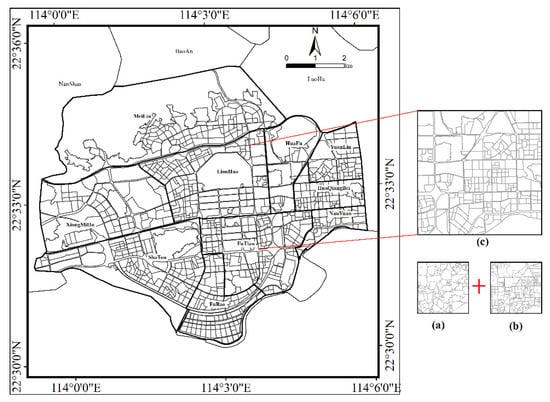
Figure 2.
Spatial unit for identifying the urban functional areas: (a) feature boundaries; (b) road network; (c) spatial unit.
2.1.2. Function Intensity
The density index of POI has often been applied to urban function assessment. Considering that the number and spatial distribution of the POIs for each type are uneven, we proposed a function-intensity index () based on the density index () and average-nearest-neighbor index () [27] of each type of POI in the spatial unit.
The average-nearest-neighbor index was used to quantify the spatial-distribution characteristics of POIs corresponding to different functions. The formula is as follows:
where is the nearest-neighbor index of the i-th type of POI in the spatial unit; denotes the distance from each point in the unit to its nearest neighbor; is the i-th type of POI in the spatial unit; Ni denotes the total number of the i-th type of POI points; A is the area of the spatial unit.
The density index () is calculated as follows:
where denotes the number of the i-th type of POI, and S denotes the area of the spatial unit.
Then, the function-intensity index () can be formulated as:
where denotes the function intensity corresponding to the i-th type of POI in a spatial unit; is the normalized density index; is the normalized average-nearest-neighbor index.
After several experiments, we found that the optimal functional-area identification was achieved when the weights for the normalized density and normalized ANNI were set to 0.7 and 0.3, respectively. This indicates the relative importance of the density and ANNI of POIs for functional-area identification.
2.1.3. Identification of Urban Functional Areas
Each spatial unit might have several types of POIs representing several urban functions. The category-of-ratio (CR) index for each type of POI within the spatial unit was obtained as follows:
where is the proportion of the functional intensity of the i-th type of POI to the functional intensity of all types of POIs in the spatial unit.
If the of one type of POI was significantly higher than those of other POI types, then we considered the unit a single-function spatial unit. Otherwise, the spatial unit was regarded as a mixed-function type. Thus, how to evaluate the relative importance and assign the main functional attributes of the spatial unit is critical. In this paper, the Grubbs criterion is employed [28]:
where is the maximal proportional value of the category of the ratio of the POI; is the average value of the proportional size of the category of the ratio of each POI type in the spatial unit; S is the standard deviation of this dataset; G (n, ), which can be referred to in Table A1 in Appendix A, represents the Grubbs threshold, with a confidence probability of , generally in the range of 9099.5%; was set as 95% [29]; n represents the number of the type of POI in a spatial unit. If Gmax> G (n, ), then the maximum value is judged as an outlier and the spatial-unit functional type is the functional type corresponding to the maximum value. If Gmax< G (n, ), then the spatial unit is a mixed-function unit consisting of urban functions corresponding to POI types with CR values greater than the mean value.
2.2. Data Source and Preprocessing
2.2.1. POIs and Urban-Function Classification
The POI data for this study were obtained from the Baidu Maps Open Platform [30]. A total of 53,498 points of interest (POIs) for Futian District were crawled using Python. Each POI record contains four attributes, including name, longitude, latitude, and address. According to the Baidu Maps classification standard, the obtained POIs cover 16 primary classifications, such as Food, Hotel, Shopping, Medical, Government Agencies, and Education and Training, and 101 secondary classifications.
Based on the “Classification of urban land use and planning standards of development land (GB 50137-2011)” issued by the Ministry of Housing and Urban-Rural Development of the People’s Republic of China (MOHURD), the POIs of Futian District were reclassified into six classes on Level I, including Administration and Public Services (A), Commercial and Business Facilities (C), Green Space (G), Industrial (I), Residential (R), and Street and Transportation (S). Because the Administration and Public Services (A) group is more comprehensive, we further subclassified it into Cultural Media, Administrative Office, Research, Education, Medical Health, and Sports Facilities on Level II. After processing, the total number of POIs was 25,604, and the types and numbers of POIs corresponding to each functional area are shown in the Table 1.

Table 1.
Land-use and POI classification system.
2.2.2. OpenStreetMap (OSM) Datasets
OSM datasets were downloaded from OpenStreetMap [31] in September 2020. The original road types of OSM include Motorway, Primary Road, Secondary Road, Tertiary Road, Trunk Road, Residential Road, and Unclassified Road (Figure 3a). We first eliminated useless road lines to obtain the main road-network outline containing only road edges. Then, the topology was edited, including the removal of broken lines, pedestrian bridges, ramps, and other miscellaneous lines, and the completion of incomplete roads based on remote-sensing images. After the above two steps, the final road network after processing was obtained (Figure 3b).
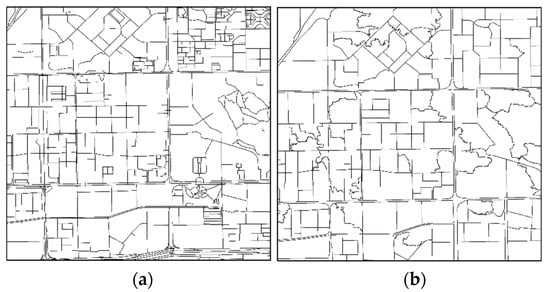
Figure 3.
OpenStreetMap data preprocessing: (a) original OSM data, and (b) final road network after processing.
2.2.3. Remote-Sensing Images
One scene of the Gaofen-1 remote-sensing image of the study area from 20 February 2020, was acquired from the China Centre for Resources Satellite Data and Application. Gaofen-1 is a Chinese high-resolution remote-sensing satellite, and the Gaofen-1 image consists of four multispectral bands at an 8 m resolution, and a panchromatic band at a 2 m resolution. We fused the panchromatic imagery and multispectral imagery for the extraction of the land-use objects.
2.3. Study Area
Shenzhen, the first special economic zone in China, has experienced unprecedented urbanization over the past 40 years and has become one of the largest metropolises in the world. The study area of Futian District is located in the central part of Shenzhen, connecting to Luohu District to the east, Nanshan District to the west, Longhua District and Longgang District to the north, and the Shenzhen River to the south (Figure 4). As the political, economic, and cultural center of Shenzhen, Futian District had a year-end resident population of 1,633,700 people in 2018. Today, Futian District is experiencing a critical period of transformation in urban development. Constrained by population, resources, and space, the new strategy of urban development has shifted the emphasis away from the expansion to the optimization of the inner urban space. The implementation of the dynamic monitoring of urban functional areas is of great significance to promote sustainable urban development.
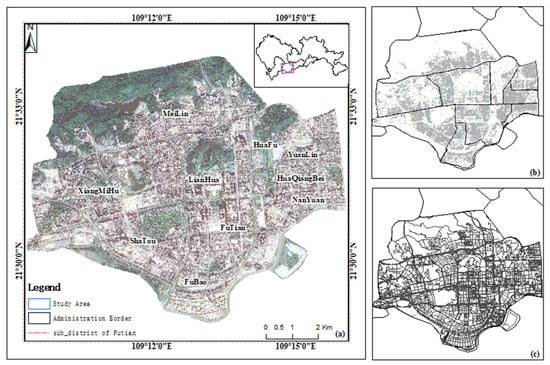
Figure 4.
(a) High-resolution images from GaoFen-1 (GF-1) covering Futian District; (b) location of Shenzhen in China; (c) POIs of Futian District.
3. Results
3.1. Spatial Heterogeneity for Each Type of POI
The distribution of POIs corresponding to different urban functions in urban space is shown in Figure 5. The Residential POIs are spatially distributed more regularly, with larger distances between POI locations (Figure 5a). The Business and Commercial elements have a larger number of POIs, mostly found in urban centers and along the streets, with smaller distances between the POI locations (Figure 5b,c). The Administration and Public Services POIs are mainly aggregated with smaller distances. The Healthcare and Schools, Green Space, and Industrial elements have fewer POI numbers, resulting in larger distances between adjacent POIs (Figure 5d–f).
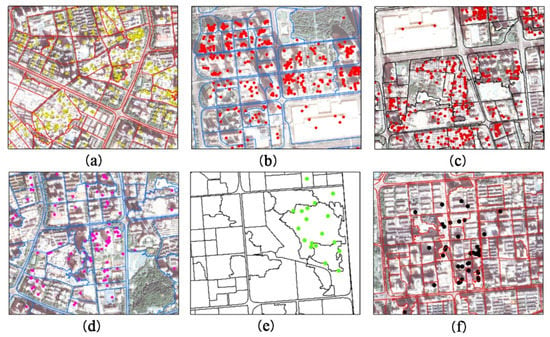
Figure 5.
Point distribution pattern of each type of POI ((a) Residential; (b) Business; (c) Commercial; (d) Administration and Public Services; (e) Green Spaces; (f) Industry).
To gain insight into the spatial distribution of the POIs corresponding to each type of functional area in the study area, we calculated the magnitude of the ANNI and drew a box plot of the normalized ANNI and normalized density index of the POIs for all spatial units in the study area, shown in Figure 6. Based on the combination of the ANNI and density index, the spatial characteristics of all POIs were divided into three categories. The first category had a large number of points, with a low normalized density index and normalized ANNI that were close, such as the POIs of Business (Figure 6a) and Commercial (Figure 6b) Facilities and Administration Office (Figure 6c), the ANNIs of which are 0.86, 0.51, and 0.40, respectively. In the Futian central business district, there are a large number of companies, such as investment and insurance companies, as well as shopping, entertainment, and leisure facilities, and the distribution of Business POIs in these areas is dense, and the average-nearest-neighbor index is low. Commercial POIs, such as supermarkets and restaurants, are distributed along the streets, and their average-nearest-neighbor indexes are generally less than 1 because many Commercial Facilities are widely located around residential and business areas. For the second category, the normalized density was much higher than the normalized ANNI. Residential was such an example (Figure 6d). There were 638 spatial units containing Residential POIs in Futian District, and the ANNI for the Residential POIs was 0.87, indicating that Residential elements are mainly clustered in space, even though they are widely distributed. The third category had a small number of POIs in the whole study area, and a low density of POIs within the spatial unit, but a large ANNI value; for example, Industry (Figure 6e), Street and Transportation (Figure 6f), and Green Space (Figure 6g). The ANNI values of the above three types of POIs are 3.67, 3.83, and 2.66, respectively, which means that these POIs are more scattered. The Administration and Public Services POIs contain six subcategories. Except for the Administration Office, with a lower ANNI of 0.4 (Figure 6c), the five other categories, including Education, Medical Health, Sports Facilities, Cultural Media, and Research, had high ANNIs, with values of 2.15 (Figure 6h), 10.45 (Figure 6i), 2.39 (Figure 6j), 1.59 (Figure 6k), and 1.78 (Figure 6l), respectively.
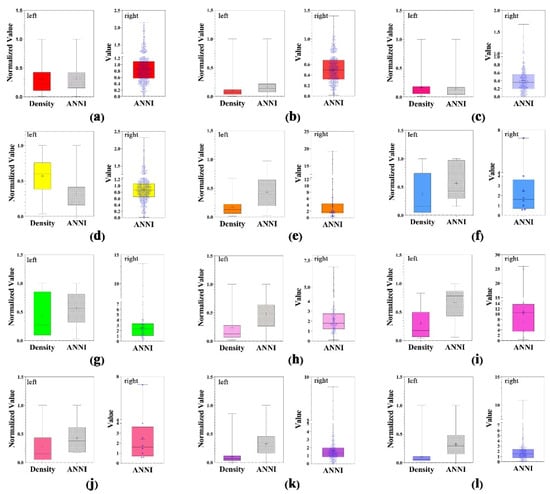
Figure 6.
Spatial statistics on average-nearest-neighbor indexes and densities of different types of POIs: (a) Business; (b) Commercial; (c) Administrative Office; (d) Residential; (e) Industrial; (f) Street and Transportation; (g) Green Spaces; (h) Education; (i) Medical Health; (j) Sport Facilities; (k) Cultural Media; (l) Research. Left: the normalized density and normalized average-nearest-neighbor indexes; Right: the average-nearest-neighbor index value.
3.2. Functional-Area-Identification Results
3.2.1. Single-Function Area
Figure 7 shows the functional areas of Futian District identified by our method. The urban function of Futian District is dominated by single-function areas, accounting for 80.27% of the total area, and the mixed-land area accounts for 19.73%.

Figure 7.
Result of the identification of single-function zones.
Among the single-function areas, the urban Green Space is the largest and most dominant functional-area type in Futian District, accounting for 38.48% of the study area. This is followed by Residential Areas (37.39%), Commercial and Business Facilities (13.65%), and Administrative and Public Services (8.52%). Large areas of urban Green Space exhibit the achievements of Shenzhen government’s effort in improving people’s well-being. Moreover, as the financial center of Shenzhen, Futian District has gathered a large number of domestic and foreign financial institutions and companies, and so the area of the Commercial and Business-function area is relatively high. With regard to the pattern of single-function areas, the residential area is distributed in all areas of Futian District, forming a circular-distribution pattern, with the central area of Futian District as the core. Commercial and Business Facilities includes two categories of land use, for business offices and commercial facilities, concentrated in the Futian Free Trade Zone in the south, the central area of Futian District, the Huaqiang Bei area in the east, and the Chegongmiao area in the west. The Administration and Public Services category is mainly distributed in the areas of Huaqiang North, Central District, and Li Zhi Park. The industrial land in Futian District is dominated by factories for garments, electronics, hardware production, and ceramics, accounting for 1% of the area. The number of industrial-land units is relatively small and mainly mixed with other functions, such as residential, commercial, and business facilities. Street and Transportation units are mainly occupied by bus stations and gas stations, accounting for 0.51% of the study area, and are mainly located in the western, central, and eastern parts of Futian District. Green Spaces are mainly located in the north of Futian District, including parks of different sizes.
3.2.2. Mixed-Function Areas
Mixed-function areas in Futian District are dominated by Residential, Commercial, and Business (RCB) Facilities and Administration and Public Services functions (Figure 8), among which RCB has the largest area, accounting for 25.36% of the total mixed-functional areas and occupying a total of 64 spatial units, which is the most dominant type of mixed-functional area in Futian District. This is followed by Residential, Administrative and Public Services, Commercial, and Business (RACB) Facilities and Administrative Public Services, Commercial, and Business (CBA) Facilities, which account for 15.35% and 11.49% of the total area of mixed-function areas, respectively (Table 2), and occupy 35 and 23 spatial units, respectively. The area of mixed-function areas of Residential and Public Services (RA) is relatively small, accounting for only 1.12% of the total area of the mixed-function areas in Futian District. The other mixed-function areas are mainly composed of Residential, Administrative and Public Services, Commercial Services, Green Space, Industrial, and Street and Transportation.
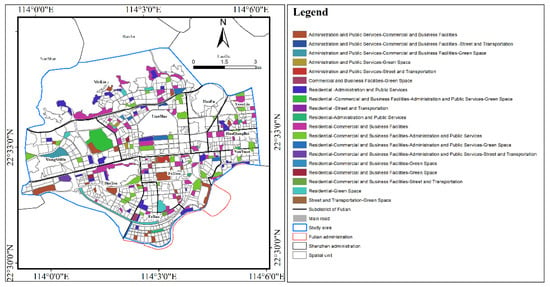
Figure 8.
Distribution of mixed-function zones.

Table 2.
Proportion of each mixed-function zone. RA, RCB, RACB, ACB, and other mixed-function zones.
The spatial distribution of the mixed-function areas is relatively uniform. Among them, RCB is mainly distributed in the central, northern, and eastern parts of Futian District. RACB is mainly distributed in the northern and eastern parts, while the spatial distributions of the mixed-function areas of RA and CBA are more scattered. Other types of mixed-function areas are mainly distributed in the northern, western, and southern parts of Futian (Figure 8).
3.3. Accuracy Assessment
To assess the accuracy of the urban-functional-area identification, 200 validation points were randomly selected with the help of ArcGIS 10.5 software. All points were confirmed using Google Earth and land-use data, which were downloaded from the Shenzhen City Planning and Land Resources Committee [32]. We used a confusion matrix to quantitatively assess the accuracy of the identification of urban functional areas by comparing the identification results with the sampled points.
The confusion matrix is given in Table 3. We obtained an overall accuracy (OA) of 81.9% for the seven categories of urban functional areas, with a kappa coefficient of 0.77. The highest accuracies were obtained for green areas and residences (95% and 93%, respectively), followed by public administration and public services (85%), while the accuracy of the mixed-function-area types was relatively low at 69%. More than one-third of the misclassified mixed-function areas were identified as Residential, which is the most important reason for the low accuracy of the mixed-function-area identification.

Table 3.
Confusion matrix of the classification of Level Ⅰ urban-land-use types.
The overall accuracy error tolerance is 81.9 ± 0.0517%, and the kappa coefficient is 0.765.
By comparison, a method based only on the density of POIs was also implemented to identify functional areas in this paper. The accuracy-assessment results for both methods are listed in Table 4. Our method has an accuracy that is approximately 11.7% higher than the method based on the density of POIs only.

Table 4.
Comparison of the accuracy of identifying urban functional areas using different methods.
Although the overall accuracy can express the degree of reliability of identifying each functional area at a macrolevel, the specific category accuracy becomes more important for scientific applications. The traditional functional-area-identification method considering only the POI density performs poorly for mixed-function areas and Administrative and Public Services, with producer’s accuracy rates of 44.7% and 59.2%, respectively, while the producer’s accuracy rates of our proposed method are 69.7% and 87.2%, respectively (Table 4).
In addition, the producer’s accuracy and user’s accuracy of Residential, Green Space, Public Administration and Public Service, and mixed-function areas are higher compared with the identification method using only the POI density, although the user’s accuracy and producer’s accuracy of Street and Transportation are a little higher than the method proposed in this paper, which may be due to the fewer number of POIs of Street and Transportation and the actual number of this functional area in the study area. The POI-density method often wrongly classified mixed-function areas, such as Residential-Public Services or Residential-Commercial Services, as Residential.
M1 indicates the method based on the density and distribution of POIs, and M2 indicates the method based on the density of POIs only. OA indicates the overall accuracy, UA indicates the user’s accuracy, and PA indicates the producer’s accuracy.
The overall accuracies of M1 and M2 are 81.9% and 70.2%, respectively.
4. Discussion
4.1. Effect of Spatial Distribution of POIs on Functional-Area Identification
Heterogeneity in urban spaces has long been recognized by many studies. Correspondingly, POI data representing urban functions also exhibit large variations over urban spaces [16,17]. How to determine the functional attributes of a given spatial unit is the key problem of the POI-based method. To tackle this problem, we introduced the average-nearest-neighbor index, together with the density index, to reduce the impact of the spatial heterogeneity of POIs on the urban-functional-area identification. The density index mainly reflects the frequency characteristics of POI data, failing to uncover the POI configuration pattern [33]. For example, the density of Commercial POIs is significantly larger than those of other POI categories, which often results in an extraordinarily high probability of classifying as a commercial area [34]. In the previous studies, kernel-density estimation was often employed to represent the distribution difference in the POI density. Studies show that kernel-density estimation can be utilized to extract the distribution characteristics of different land uses from POI semantic information, enabling us to infer the building functions, and particularly for functional buildings with significant spatial aggregations [35,36]. However, when applied to heterogeneous functional-area identification, the accuracy is greatly reduced. In addition, the identification result is sensitive to the bandwidth of the kernel-density estimation [37].
The average-nearest-neighbor index is often used to explore urban spatial characteristics, such as the spatial aggregation or uniform distribution of urban elements [38,39,40,41]. In our study, the average-nearest-neighbor index was mainly used to balance the impact of the uneven POI density on determining the functional characteristic of the unit. For example, when a spatial unit contains the POIs of both Administrative and Public Services and Residential or Commercial and Business Facilities, the function label of this unit will largely be assigned to Residential or Commercial and Business Facilities because the former POIs are lower in density due to their smaller number, which results in a situation in which these functions are often at a disadvantage when mixed with Residential or Commercial and Business Facilities with high POI densities. That is why the Residential or Commercial and Business Facilities were often overestimated when only the POI density was used for the functional-area identification. However, the average-nearest-neighbor index represents the degree of separation or aggregation of points in a specific spatial unit. Although some kinds of points are fewer in number, they are more scattered and occupy most of the unit, which results in high ANNI values. Therefore, when the ANNI was incorporated, it had the capacity to increase the importance of the scattered POIs with low density when identifying functional areas, improving the accuracy for mixed-function areas. In this paper, the identification accuracy of mixed-function areas is 25% higher than when using only the density of POIs. The identification accuracy of Public Services is 18% higher, and the overall accuracy is 11% higher, indicating that the introduction of the spatial-distribution characteristics of the POIs can effectively distinguish between single- and mixed-function areas, thus improving the recognition effect of urban functional areas.
Because the density of POIs and the average-nearest-neighbor index are weight summed, the weight values for the two factors should be set cautiously. When the weight of the average-nearest-neighbor index is set too large, the functional-area attributes may tend to be determined by the urban functions corresponding to the POIs with higher mean-nearest-neighbor index types. When the weight of the mean-nearest-neighbor index is set too small, it is not conducive to overcoming the problem of the spatial heterogeneity of POIs.
4.2. Impact of Spatial-Unit Division on Functional-Area Identification
Spatial-unit division is the basis for functional-area identification by a POI-based method. In this paper, we integrated the object layer from a high-resolution remote-sensing classification with road networks from OSM data to produce the spatial-unit layer for urban functional identification. Blocks are most often used as the basic units for urban studies [19,20,37] because they have clear functional meanings [21,42] (e.g., residential, commercial, and industrial districts). However, the road network is often so coarse that one road network may include multiple functional areas, which limits the road-network unit to a broad functional-area identification. Moreover, functional-area units obtained by object-segmentation methods [43,44] can hardly match the heterogeneous POIs, even when using large-scale parameters, as functional zones have substantial discontinuities in the visual cues of spectrums, edges, and textures [45]. Most functional areas are not only spatially larger than objects but are also semantically different from objects. In this study, through the integration of image segmentation with road networks, the road-network units as boundaries are conducive to maintaining the integrity and continuity of urban functions, while the smaller urban functional areas within a spatial unit can be accurately depicted. As a result, the division units are more consistent with the realistic spatial-distribution patterns of urban functions. Considering diverse urban functions, city scales, economic levels, and even topographies, several studies have noted that the spatial division of functional areas is difficult, and no single method can be regarded as universal to all situations [13]. However, the method used in our research, based on multisource-data features, is conducive to narrowing the scope of recognized regions and reducing the interference between multiple attributes of regions, and it has the potential to be applied to other urban areas at different scales for spatial-unit partitioning.
4.3. Adaptive Threshold for Determining Functional Area
In this study, we constructed a comprehensive function-intensity index to reflect the importance of various POIs in a spatial unit. Considering that several functions may coexist in a spatial unit, a threshold for evaluating the different functions is needed to determine whether a spatial unit is single-function or mixed.
When using the POI density as a reference, some studies set the threshold value to 0.5 [26,36,46] (i.e., the urban function corresponding to the POI type with a density-index ratio greater than 0.5 is taken as the main function of the spatial unit; conversely, the spatial unit will be judged to be a mixed-function area). However, this arbitrary-split method sets a fixed-threshold value in advance that may cause functional-area-identification results that are far from the truth where the proportions of various functions in a spatial unit are close to each other. For example, assume that there are three functions in a spatial unit, C1, C2, and C3, the functional-intensity ratios of which are 0.02, 0.47, and 0.51, respectively. If 0.5 is used as the judgment threshold, then the functional properties of the spatial unit will be determined by C3, but in fact, it is more reasonable to judge the spatial unit as a mixed-function type consisting of C2 and C3 functions. In this study, we employed the Grubbs criterion to test the outliers for the adaptive determination of the threshold. This approach fully takes into account the relationship among the proportions of different functions within the unit. If an outlier of CR of a given POI-function category exists in a spatial unit, then its main function should be much more important than the other functions, and thus it will be judged as a single-function area; on the contrary, if the spatial unit has no outliers, then the spatial unit will be regarded as a mixed-function area consisting of functions with a higher-than-average proportion.
To further understand the difference between the fixed-threshold method and the Grubbs criterion in determining single- and mixed-function areas, we counted the functional-intensity ratios of all urban functions in mixed-function areas determined by both methods, and we calculated the difference between the maximum and the second largest value of the functional-intensity ratio shown in Figure 9. Under the Grubbs criterion, most of the functional-intensity ratios of various types of urban functions in mixed-function areas are relatively close to each other, and the difference is mainly below 0.20. This is more in line with the notion that the proportion of a certain functional intensity in a single-function area should be dominant, and the difference in the proportion of each functional intensity in mixed-function areas should not be significant. Therefore, the Grubbs test can be a potential criterion to distinguish between single-function areas and mixed-function areas to improve the accuracy of urban-functional-area identification.
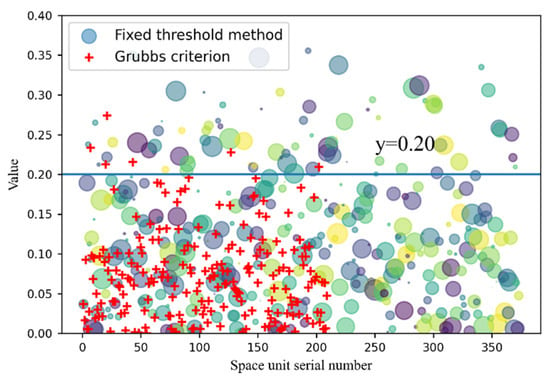
Figure 9.
Distribution of the differences between the maximum value and the second largest value of the functional-intensity ratio of mixed-function areas based on the fixed-threshold method and Grubbs criterion.
5. Conclusions
In this paper, we proposed a new scheme for urban-functional-area identification by integrating POI data, OSM road-network data, and high-resolution remote-sensing images. The multiscale object-oriented segmentation of high-resolution remote-sensing images was fused with road networks to obtain the spatial unit (urban functional area). A new function-intensity index that integrates the density index and ANNI of POIs was built to represent urban functions, and the Grubbs criterion was employed to determine the final urban function of a given spatial unit. The results showed that the spatial heterogeneity of POIs could be well taken into account in urban-functional-area identification. The introduction of the Grubbs criterion also helps to rationally distinguish single-function areas from mixed-function areas. When applied to Futian District, Shenzhen, our method depicts the urban functional areas at a detailed level, and the overall accuracies of identification are much improved. Because the spatial heterogeneity of POIs is specific to each urban area, further research requires more case studies to analyze in depth the quantitative relationship among the urban building density, landscape pattern, and spatial heterogeneity of POIs at different scales. Then, an automated method for optimizing the weights of the density index and ANNI can be developed to balance the effect of the POI amount and spatial heterogeneity to thus strengthen the applicability of the method to other cities at different levels of development.
Author Contributions
Conceptualization, C.H. and L.R.; methodology, C.X. and C.H.; software, C.X.; validation, C.X., C.H. and L.R.; formal analysis, C.H.; investigation, C.H.; re-sources, C.H. and L.R.; data curation, C.X.; writing—original draft preparation, C.X.; writing—review and editing, C.H. and L.R.; visualization, C.X.; supervision, L.R.; funding acquisition, C.H. All authors have read and agreed to the published version of the manuscript.
Funding
This research was funded by the National Natural Science Foundation of China grant number (41890854).
Data Availability Statement
Data available in a publicly accessible repository that does not issue DOIs.
Conflicts of Interest
The authors declare no conflict of interest.
Appendix A

Table A1.
Practical table for several critical values of the Grubbs criterion (G(n,ρ)).
Table A1.
Practical table for several critical values of the Grubbs criterion (G(n,ρ)).
| 90.0% | 95.0% | 97.5% | 99.0% | 99.5% | ||
|---|---|---|---|---|---|---|
| .N | ||||||
| 3 | 1.148 | 1.153 | 1.155 | 1.155 | 1.155 | |
| 4 | 1.425 | 1.463 | 1.481 | 1.492 | 1.496 | |
| 5 | 1.602 | 1.672 | 1.715 | 1.749 | 1.764 | |
| 6 | 1.729 | 1.822 | 1.887 | 1.944 | 1.973 | |
| 7 | 1.828 | 1.938 | 2.020 | 2.097 | 2.139 | |
| 8 | 1.909 | 2.032 | 2.126 | 2.220 | 2.274 | |
| 9 | 1.977 | 2.110 | 2.215 | 2.323 | 2.387 | |
| 10 | 2.036 | 2.176 | 2.290 | 2.410 | 2.482 | |
| 11 | 2.088 | 2.234 | 2.355 | 2.485 | 2.564 | |
| 12 | 2.134 | 2.285 | 2.412 | 2.550 | 2.636 | |
| 13 | 2.175 | 2.331 | 2.462 | 2.607 | 2.699 | |
| 14 | 2.213 | 2.371 | 2.507 | 2.659 | 2.755 | |
| 15 | 2.247 | 2.409 | 2.549 | 2.705 | 2.806 | |
| 16 | 2.279 | 2.443 | 2.585 | 2.747 | 2.852 | |
References
- Pickett, S.T.A.; Cadenasso, M.L.; Rosi-Marshall, E.J.; Belt, K.T.; Groffman, P.M.; Grove, J.M.; Irwin, E.G.; Kaushal, S.S.; LaDeau, S.L.; Nilon, C.H.; et al. Dynamic heterogeneity: A framework to promote ecological integration and hypothesis generation in urban systems. Urban Ecosyst. 2017, 20, 1–14. [Google Scholar] [CrossRef]
- Luck, M.; Wu, J. A gradient analysis of urban landscape pattern: A case study from the Phoenix metropolitan region, Arizona, USA. Landsc. Ecol. 2002, 17, 327–339. [Google Scholar] [CrossRef]
- Pickett, S.T.A.; Cadenasso, M.L.; McGrath, B. (Eds.) Resilience in Ecology and Urban Design: Linking Theory and Practice for Sustainable Cities; Springer: New York, NY, USA, 2013. [Google Scholar]
- Vanderhaegen, S.; Canters, F. Mapping urban form and function at city block level using spatial metrics. Landsc. Urban Plan. 2017, 167, 399–409. [Google Scholar] [CrossRef]
- Zhou, W.Q.; Pickett, S.T.A.; Cadenasso, M.L. Shifting concepts of urban spatial heterogeneity and their implications for sustainability. Landsc. Ecol. 2017, 32, 15–30. [Google Scholar] [CrossRef]
- Shane, D.G. Urban Design since 1945–A Global Perspective; Wiley: Chichester, UK, 2011. [Google Scholar]
- Izzo, S.; Prezioso, E.; Giampaolo, F.; Mele, V.; Somma, V.D.; Mei, G. Classification of urban functional zones through deep learning. Neural Comput. Appl. 2022, 34, 6973–6990. [Google Scholar] [CrossRef]
- Xu, N.; Luo, J.; Wu, T.; Dong, W.; Liu, W.; Zhou, N. Identification and portrait of urban functional zones based on multisource heterogeneous data and ensemble learning. Remote Sens. 2021, 13, 373. [Google Scholar] [CrossRef]
- Song, J.; Lin, T.; Li, X.; Prishchepov, A.V. Mapping urban functional zones by integrating very high spatial resolution remote sensing imagery and points of interest: A case study of Xiamen, China. Remote Sens. 2018, 10, 1737. [Google Scholar] [CrossRef]
- Chen, J.; Turkstra, J.; Peng, M.; Du, N.; Ho, P. Urban land administration and planning in China: Opportunities and constraints of spatial data models. Land Use Policy 2006, 23, 604–616. [Google Scholar] [CrossRef]
- Van de Voorde, T.; Jacquet, W.; Canters, F. Mapping form and function in urban areas: An approach based on urban metrics and continuous impervious surface data. Landsc. Urban Plan. 2011, 102, 143–155. [Google Scholar] [CrossRef]
- Wellmann, T.; Lausch, A.; Andersson, E.; Knapp, S.; Cortinovis, C.; Jache, J.; Kraemer, R. Remote sensing in urban planning: Contributions towards ecologically sound policies? Landsc. Urban Plan. 2020, 204, 103921. [Google Scholar] [CrossRef]
- Zhang, X.; Du, S.; Wang, Q. Hierarchical semantic cognition for urban functional zones with VHR satellite images and POI data. ISPRS J. Photogramm. Remote Sens. 2017, 132, 170–184. [Google Scholar] [CrossRef]
- Liu, X.; He, J.; Yao, Y.; Zhang, J.; Liang, H.; Wang, H.; Hong, Y. Classifying urban land use by integrating remote sensing and social media data. Int. J. Geogr. Inf. Sci. 2017, 31, 1675–1696. [Google Scholar] [CrossRef]
- Arsanjani, J.; Helbich, M.; Bakillah, M.; Hagenauer, J.; Zipf, A. Toward mapping land-use patterns from volunteered geographic information. Int. J. Geogr. Inf. Sci. 2013, 27, 2264–2278. [Google Scholar] [CrossRef]
- Andrade, R.; Alves, A.; Bento, C. POI mining for land use classification: A case study. ISPRS Int. J. Geo-Inf. 2020, 9, 493. [Google Scholar] [CrossRef]
- Yeow, L.; Low, R.; Tan, Y.; Cheah, L. Point-of-Interest (POI) Data Validation Methods: An Urban Case Study. ISPRS Int. J. Geo-Inf. 2021, 10, 735. [Google Scholar] [CrossRef]
- Crooks, A.; Pfoser, D.; Jenkins, A.; Croitoru, A.; Stefanidis, A.; Smith, D.; Karagiorgou, S.; Efentakis, A.; Lamprianidis, G. Crowdsourcing urban form and function. Int. J. Geogr. Inf. Sci. 2015, 29, 720–741. [Google Scholar] [CrossRef]
- Heiden, U.; Heldens, W.; Roessner, S.; Segl, K.; Esch, T.; Mueller, A. Urban structure type characterization using hyperspectral remote sensing and height information. Landsc. Urban Plan. 2012, 105, 361–375. [Google Scholar] [CrossRef]
- Montanges, A.P.; Moser, G.; Taubenböck, H.; Wurm, M.; Tuia, D. Classification of urban structural types with multisource data and structured models. In Proceedings of the 2015 Joint Urban Remote Sensing Event (JURSE), Lausanne, Switzerland, 30 March–1 April 2015; pp. 1–4. [Google Scholar]
- Neis, P.; Zipf, A. Analyzing the contributor activity of a volunteered geographic information project—The case of OpenStreetMap. ISPRS Int. J. Geo-Inf. 2012, 1, 146–165. [Google Scholar] [CrossRef]
- Zhang, X.; Du, S. A linear Dirichlet mixture model for decomposing scenes: Application to analyzing urban functional zonings. Remote Sens. Environ. 2015, 169, 37–49. [Google Scholar] [CrossRef]
- Liu, Y.; Tian, Y.; Zhang, X.; Wan, Z. Identification of urban functional regions in chengdu based on taxi trajectory time series data. ISPRS Int. J. Geo-Inf. 2020, 9, 158. [Google Scholar] [CrossRef] [Green Version]
- Pei, T.; Sobolevsky, S.; Ratti, C.; Shaw, S.-L.; Li, T.; Zhou, C. A new insight into land use classification based on aggregated mobile phone data. Int. J. Geogr. Inf. Sci. 2014, 28, 1988–2007. [Google Scholar] [CrossRef]
- Deng, Y.; Liu, J.; Liu, Y.; Luo, A. Detecting urban polycentric structure from POI data. ISPRS Int. J. Geo-Inf. 2019, 8, 283. [Google Scholar] [CrossRef]
- Hu, Y.; Han, Y. Identification of urban functional areas based on POI data: A case study of the Guangzhou economic and technological development zone. Sustainability 2019, 11, 1385. [Google Scholar] [CrossRef]
- Clark, P.J.; Evans, F.C. Distance to Nearest Neighbour as a Measure of Spatial Relationship in Population. Ecology 1954, 35, 445–453. [Google Scholar] [CrossRef]
- Cao, Y.; Liu, J.; Wang, Y.; Wang, L.; Wu, W.; Su, F. A Study on the Method for Functional Classification of Urban Buildings by Using POI Data. J. Geo-Inf. Sci. 2020, 22, 1339–1348. [Google Scholar]
- Zhou, Y.; Jiang, X.; Zhang, M.; Zhang, J.; Sun, H.; Li, X. Modal parameters identification of bridge by improved stochastic subspace identification method with Grubbs criterion. Meas. Control. 2021, 54, 457–464. [Google Scholar] [CrossRef]
- Baidu Maps Open Platform. 2020. Available online: https://lbsyun.baidu.com/index.php?title=%E9%A6%96%E9%A1%B5 (accessed on 4 May 2020).
- Open Street Map. 2020. Available online: https://https://www.openhistoricalmap.org/#map=5/51.440/-0.088&layers=O (accessed on 16 May 2020).
- Shenzhen City Planning and Land Resources Committee. 2020. Available online: http://pnr.sz.gov.cn/ywzy/fdtz/cggbcx/ftq/index.html (accessed on 1 June 2020).
- Liu, K.; Yin, L.; Lu, F.; Mou, N. Visualizing and exploring POI configurations of urban regions on POI-type semantic space. Cities 2020, 99, 102610. [Google Scholar] [CrossRef]
- Sun, J.; Wang, H.; Song, Z.; Lu, J.; Meng, P.; Qin, S. Mapping essential urban land use categories in nanjing by integrating multi-source big data. Remote Sens. 2020, 12, 2386. [Google Scholar] [CrossRef]
- Miao, R.; Wang, Y.; Li, S. Analyzing Urban Spatial Patterns and Functional Zones Using Sina Weibo POI Data: A Case Study of Beijing. Sustainability 2021, 13, 647. [Google Scholar] [CrossRef]
- Wang, Z.; Ma, D.; Sun, D.; Zhang, J. Identification and analysis of urban functional area in Hangzhou based on OSM and POI data. PLoS ONE 2021, 16, e0251988. [Google Scholar] [CrossRef]
- Lin, A.; Sun, X.; Wu, H.; Luo, W.; Wang, D.; Zhong, D.; Wang, Z.; Zhao, L.; Zhu, J. Identifying Urban Building Function by Integrating Remote Sensing Imagery and POI Data. IEEE J. Sel. Top. Appl. Earth Obs. Remote Sens. 2021, 14, 8864–8875. [Google Scholar] [CrossRef]
- Agbabiaka, H.I.; Aguda, A.S.; Nzere, R.B. Spatial distribution and proximal model of secondary educational facilities in a traditional Nigerian city. J. Oper. Res. Soc. 2020, 71, 1780–1798. [Google Scholar] [CrossRef]
- Bulti, D.T.; Bedada, T.B.; Diriba, L.G. Analyzing spatial distribution and accessibility of primary schools in Bishoftu Town, Ethiopia. Spat. Inf. Res. 2019, 27, 227–236. [Google Scholar] [CrossRef]
- Ghodousi, M.; Sadeghi-Niaraki, A.; Rabiee, F.; Soo-Mi, C. Spatial-Temporal Analysis of Point Distribution Pattern of Schools Using Spatial Autocorrelation Indices in Bojnourd City. Sustainability 2020, 12, 7755. [Google Scholar] [CrossRef]
- Masoudi, M.; Tan, P.; Liew, S. Multi-city comparison of the relationships between spatial pattern and cooling effect of urban green spaces in four major Asian cities. Ecol. Indic. 2019, 98, 200–213. [Google Scholar] [CrossRef]
- Zheng, X.; Wang, Y.; Gan, M.; Zhang, J.; Teng, L.; Wang, K.; Shen, Z.; Zhang, L. Discrimination of settlement and industrial area using landscape metrics in rural region. Remote Sens. 2016, 8, 845. [Google Scholar] [CrossRef]
- Baatz, M.; Schape, A. Multiresolution segmentation: An optimization approach for high quality multi-scale image segmentation. Angew. Geogr. Inf. 2000, 12, 12–23. [Google Scholar]
- Drâgut, L.; Csillik, O.; Eisank, C.; Tiede, D. Automated parameterisation for multi-scale image segmentation on multiple layers. ISPRS J. Photogramm. Remote Sens. 2014, 88, 119–127. [Google Scholar] [CrossRef]
- Pertuz, S.; Garcia, M.A.; Puig, D. Focus-aided scene segmentation. Comput. Vis. Image Underst. 2015, 133, 66–75. [Google Scholar] [CrossRef]
- Luo, S.; Liu, Y.; Du, M.; Gao, S.; Wang, P.; Liu, X. The Influence of Spatial Grid Division on the Layout Analysis of Urban Functional Areas. ISPRS Int. J. Geo-Inf. 2021, 10, 189. [Google Scholar] [CrossRef]
Publisher’s Note: MDPI stays neutral with regard to jurisdictional claims in published maps and institutional affiliations. |
© 2022 by the authors. Licensee MDPI, Basel, Switzerland. This article is an open access article distributed under the terms and conditions of the Creative Commons Attribution (CC BY) license (https://creativecommons.org/licenses/by/4.0/).